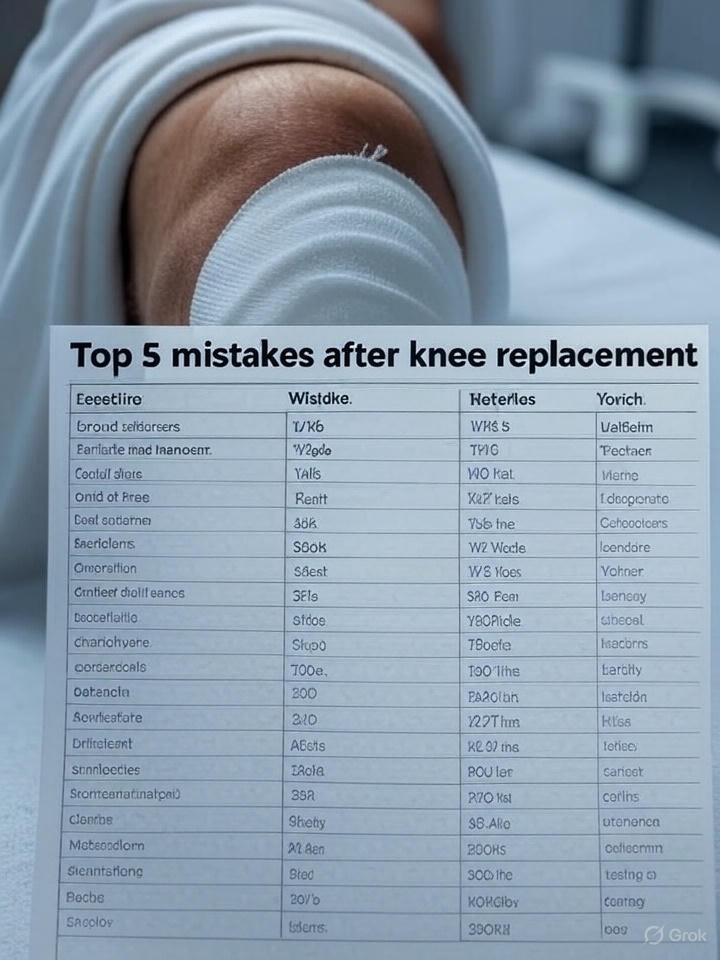Top 5 mistakes after knee replacement

Recovering from knee replacement surgery can feel overwhelming, but knowing what not to do can make all the difference in achieving a smooth and speedy recovery. Many patients focus on the best exercises or pain management techniques but overlook the small mistakes that can delay healing. This guide will walk you through the top 5 mistakes after knee replacement, plus extra tips to help you get back to full mobility faster.
1. Doing Too Much Too Soon
One of the most common errors after knee replacement is rushing the process. While it’s tempting to get back to normal activities quickly, your body needs time to heal. Overexerting yourself can cause swelling, pain, and even damage to your new joint. Stick to the recovery timeline provided by your surgeon and increase activity levels gradually. If you feel sharp pain, stop immediately and consult your healthcare provider.
2. Skipping Your Physiotherapy Routine
Your physical therapy exercises are not optional—they are essential. Many patients skip sessions or reduce exercise frequency due to discomfort, but this slows progress and reduces long-term mobility. Consistent physiotherapy strengthens the muscles around your knee, improves flexibility, and helps you return to daily activities sooner. Even on days when you feel tired, light stretching and gentle movement can prevent stiffness.
3. Ignoring Severe Pain or Warning Signs
Some discomfort after knee replacement is normal, but severe or worsening pain should never be ignored. Pain may be a sign of overuse, infection, or improper healing. Always report new or intense symptoms to your surgeon or physiotherapist immediately. Early intervention can prevent complications and ensure your recovery stays on track.
4. Neglecting Wound Care and Medication
Proper wound care is crucial for preventing infection. Always follow the instructions given by your medical team regarding cleaning, dressing changes, and keeping the area dry. Take prescribed medication as directed—whether it’s for pain relief or to manage other health conditions. Skipping doses can lead to discomfort, delayed healing, or even serious complications.
5. Trying to Recover Alone
Support from healthcare professionals, friends, and family is vital during your recovery. Attempting to manage everything yourself can lead to overexertion and unnecessary stress. Use walking aids like crutches or frames when advised, accept help with household tasks, and rely on your medical team’s guidance. Recovery is not a solo mission—having assistance speeds up healing and reduces risks.
Other Common Mistakes to Avoid After Knee Replacement
While the top 5 mistakes after knee replacement are the most critical, there are several other habits to watch out for:
- Sleeping with a pillow directly under your knee (can cause joint bending)
- Sitting with legs crossed (puts excess strain on the joint)
- Using low or soft chairs (difficult to get up without pressure on the knee)
- Wearing unsupportive shoes (increases risk of slips or falls)
- Sitting still for long periods (leads to stiffness)
Activities and Exercises to Avoid After Knee Surgery
High-impact sports and activities that involve jumping, twisting, or sudden changes in direction should be avoided. Examples include:
- Running or jogging
- Contact sports like football or basketball
- Heavy weightlifting
- Skiing or similar high-fall-risk activities
Instead, choose low-impact exercises such as swimming, cycling on a stationary bike, and gentle walking once cleared by your doctor.
What to Do for a Faster Recovery
- Keep up with your prescribed exercise program
- Use ice packs to reduce swelling
- Eat a balanced diet rich in protein and vitamins
- Get plenty of rest between activity sessions
- Maintain a healthy weight to reduce stress on your knee
Final Thoughts
Avoiding the top 5 mistakes after knee replacement can make your recovery smoother, safer, and quicker. By pacing yourself, sticking to your physiotherapy plan, paying attention to warning signs, caring for your wound, and seeking help when needed, you’ll give your knee the best possible chance to heal. Remember—knee replacement recovery is a marathon, not a sprint.










